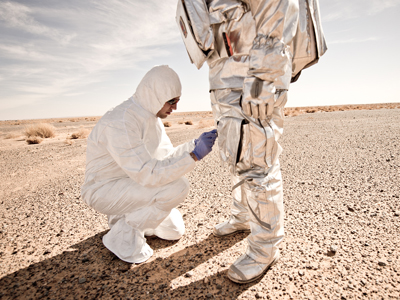microEVA

MICROsphere and Endospore Viability Assay (microEVA)
Description: Luminescence detection of viable bacterial spores and terbium microspheres to identify desert microbiological hotspots and mitigate forward contamination.
PI: Dr. Adrian Ponce
Organization: NASA Jet Propulsion Laboratory, California Institute of Technology
Summary
The science return from field work could be increased by a portable field instrument that rapidly screens samples to determine those likely to contain greater amounts of microbial life, insuring that there will be sufficient biological material for further lab analysis of the samples. Using a portable instrument, we use viable bacterial spores as an indicator of biomass levels.
With the same instrument used for spore detection, we propose to investigate forward contamination by measuring the transfer probability of luminescent microspheres from the suit tester to the sample during a variety of sample acquisition methodologies.
Both the spore and microsphere detection is based on time gated imaging of the long lifetime luminescence from terbium ions. When viable bacterial spores enter the first stage of returning to a vegetative state (germination) they release a large amount of dipicolinic acid, a bacterial spore specific marker that favorably binds with terbium ions creating a luminescent complex when excited in the UV. By using a chemical germinant to induce germination in the presence of terbium we can measure individual viable spores.
Objectives
Test the forward contamination probabilities for a variety of sample acquisition protocols by monitoring the transfer of terbium microspheres from the suit tester to the sample.
Experiment Data
| Directories/files | Description |
|---|---|
| 08-Feb-2013 | 1 report file and 3 image files |
| 11-Feb-2013 | 1 report file |
| 13-Feb-2013 | 1 report file |